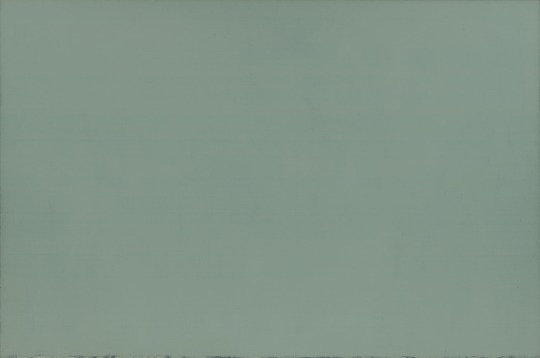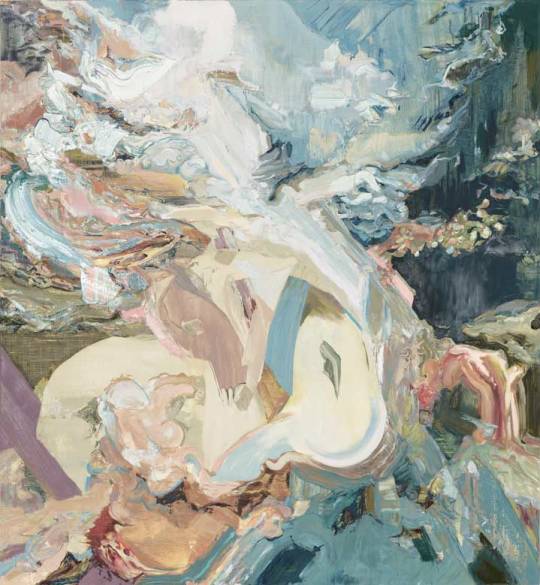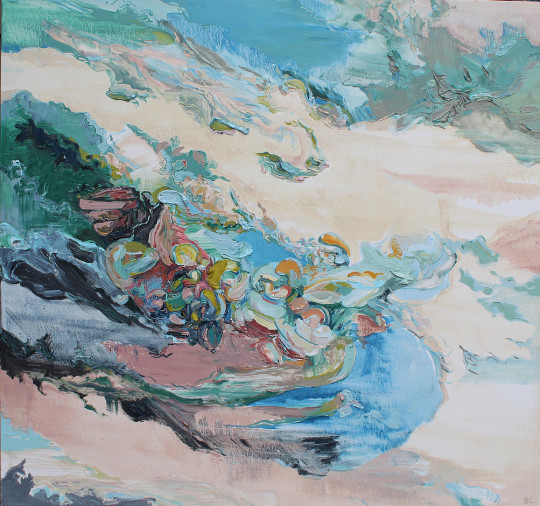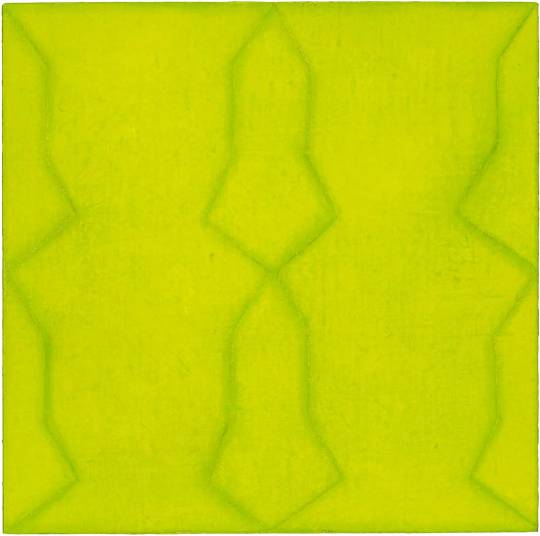#SAI W20 Abstraction 08 Abstracting the Landscape
Photo

Richard Diebenkorn (American 1922-1993). In 1976, Diebenkorn moved to the Ocean Park neighborhood of Venice, California, where he started making the series of paintings named for his new home. The Ocean Park series would ultimately come to number 145 paintings, the body of work he is best known for. The light and space of his location influenced the construction of these works, which contain implied horizons, lawns, architecture, and roads.
Ocean Park #105 1978. Oil and charcoal on canvas, 100 x 93 inches. Modern Art Museum of Fort Worth, Forth Worth, Texas.
3 notes
·
View notes
Photo

Brice Marden (American b. 1938). While this painting might not seem, at first glance, to have a direct relationship to the landscape, it was part of a series of works inspired by Marden’s visit to an olive grove in Greece. Marden’s colors are often drawn from nature. The individual panels in the Grove Group series are composed of foliage-inspired greens, blues drawn from Mediterranean water and sky, and rocky, earthy grays and browns. It is my understanding that the green pigment he used in some of the paintings from this series is terre verte, a mined green mineral pigment whose use dates back at least as far as the Renaissance. That would suggest that this landscape-derived work might in fact contain pigment dug from the earth itself. Marden’s fascination with terre verte continues to this day; in 2017 he exhibited a body of work using that single pigment, each painting featuring terre verte paint sold by different manufacturers.
Grove Group I 1972-73. Oil and wax on canvas, 69 x 105 inches. Museum of Modern Art, New York.
1 note
·
View note
Photo



Drie Chapek (American b. 1979). One does not need to look very hard to see intimations of landscape in Chapek’s work. I once heard her give an artist talk in which she talked about walking through a damp, muddy landscape, feeling the soggy soil underneath her feet. These paintings seem evocative of experiences like that.
Unravel 2018. Oil on canvas, 52 x 48 inches.
Serene 2018. Oil on canvas, 34 1/2 x 37 inches.
Want Willows Weeping 2019. Oil on canvas, 52 x 48 inches.
1 note
·
View note
Photo

Joan Mitchell (American 1925-1992). Mitchell wrote, in a letter dated 1958, “...I paint from remembered landscapes that I carry with me.” Her titles refer to gardens and other locations; La Seine was painted the year she purchased a property overlooking that river in France. Her use of multiple panels is always interesting. Here, the panels are arranged to form a broad, landscape-like horizontal, but there is also repetition from panel to panel, especially along the bottom, where those dark rectangles move about; taken as a whole, the composition is surprisingly symmetrical.
La Seine 1967. Oil on canvas, four parts, 76 7/8 x 165 7/8 inches. Governor Nelson A. Rockefeller Empire State Plaza Art Collection, New York State, Office of General Services. Source.
1 note
·
View note
Photo



Cecily Brown (British b. 1969). Brown’s paintings seem to be equally concerned with nature as they are with the human body, and oftentimes she takes both as her subject. Many of her paintings contain the figure, sometimes clearly rendered and sometimes only hinted at. I read something like landscape in the top two works, in particular. There is a pleasing messiness to these paintings, and the artist never seems to run out of ways to manipulate oil paint. If this work appeals to you, you can visit her monumental canvas in the lobby of the Hyatt Regency in downtown Seattle, where I took the badly distorted panorama seen at bottom. The painting can be seen from the street if you’re walking on Olive Way.
The Haunter 2010. Oil on linen, 97 x 103 inches. Source.
Dreamboat 2011. Oil on linen, 55 x 77 inches. Source.
Bring Me the Sunset in a Cup 2017-18. Oil on linen, 33 feet wide by 9 feet tall. Hyatt Regency Seattle, 808 Howell Street.
1 note
·
View note
Photo


Howard Hodgkin (British 1932-2017). Cecily Brown seems to immerse us in her chaotic landscapes; Hodgkin’s resemble painted stage sets viewed from theater seats. He makes clever use of framing devices, some of which are actual, three-dimensional frames he has incorporated into the painting itself. The spatial organization of Rain is of particular interest to me: the artist frames the view for us using broad blue-gray brush strokes. Beyond that, we see various colored components marching off into the distance. There is a very clear progression from foreground to background. Hodgkin was known for painting and repainting these works over and over again until the marks were exactly right, and the date range reflect the period of time it took to finish each painting. He was apparently also in the habit of reworking paintings after they had been exhibited.
Red Bermudas 1978-80. Oil on wood, 27 3/4 x 27 3/4 inches. Museum of Modern Art, New York.
Rain 1984-89. Oil paint on composite panel, 64 1/2 x 70 1/2 inches. Tate Gallery, London.
1 note
·
View note
Photo

Darren Waterston (American b. 1965). Waterston’s spaces seem to be based not so much on his observed environment as they are on the environment as it has been depicted by artists throughout history. Works like this one are simultaneously suggestive of Renaissance panel painting, Chinese landscape painting, and mid-20th century science fiction illustration.
Morphology No. 3 2016. Oil on wood panel, 25 x 25 inches. Source.
1 note
·
View note
Photo





Margie Livingston (American b. 1953). Seattle artist Livingston has the distinction of using the landscape as a direct collaborator. The body of work represented here was created by dragging panels--prepared in advance with multiple layers of paint--over roads, trails, and rocks. The artist makes a harness for each panel, attaches it to her body, and drags it behind her as she walks. The final composition is created as the layers of paint are gradually worn away. For more ambitious hikes she sews a backpack to go with the harness. The finished work, scarred and worn, is then exhibited alongside the harness and whatever walking stick she carried with her.
The fourth image shows Livingston on a hike in the Cascades, a painting on the rocks behind her. The resemblance to Caspar David Friedrich’s Wanderer Above the Sea of Fog is intentional; Livingston received a Fulbright Scholarship in 2001 to study that artist’s beautiful drawings of trees.
Dragged Blue Painting with Orange Under 2016. Oil and dirt on canvas with rope, 30 x 22 inches. Source.
Day Hike: Lake 22 2018. Gouache and acrylic on panel with canvas, fabric, hardware, and stick; 71 x 35 x 8 inches (dimensions variable). Source.
55 Laps (days one through ten) 2018. Gouache and acrylic on panel, hardware; ten panels, 30 1/2 x 23 1/2 inches each. Installation view: The Earth is a Brush exhibition, Luis de Jesus Los Angeles, January 11 - February 22, 2020.
Photo documentation of performance Day Hike: Lake 22 2018. Photo: Becs Richards. Source.
Caspar David Friedrich (German 1774-1840). Wanderer Above the Sea of Fog 1818. Oil on canvas, 37.3 x 29.4 inches. Kunsthalle Hamburg, Hamburg, Germany. Source.
1 note
·
View note
Photo


Lynne Woods Turner (American b. 1951). A very different evocation of landscape. I once saw a show pairing Turner’s spare abstractions with Drie Chapek’s lush works, and the contrast was striking. Yet, both artists mentioned landscape in their talks. Turner specifically referred to topiary with regard to these two paintings, and I think the inspiration is clear. These paintings are deceptively simple-looking. Turner’s techniques include rubbing and sanding her surfaces, applying and reapplying color in many layers and generating a surface that communicates all of the love and attention she has directed towards it.
Untitled 9274 2017. Pencil and oil on linen over panel, 14 x 14 inches.
Untitled 9297 2018. Oil on linen over panel, 10 x 8 inches.
1 note
·
View note
Photo


James Lavadour (American and Umatilla b. 1951). Lavadour’s heavily manipulated surfaces are evocative of the landscape in Eastern Oregon and Washington, which is where he lives. The paintings, themselves composed of layers of paint, often suggest geological sedimentary layers. He tends to work small, like Hodgkin; both artists have a knack for mark-making.
Golden 2018. Oil on panel, 28 x 32 inches. Source.
In Plain Sight 2019. Oil on panel, 28 x 32 inches. Source.
0 notes
Photo


Philip Govedare (American b. 1954). At some point in the 1990s, Govedare, who teaches painting at the University of Washington, shifted from working in a flat mode influenced by Abstract Expressionism to creating these invented aerial landscapes. The reason for the switch, he has said, was his growing concern for the environment. The scars of human intervention can be seen everywhere in the foreshortened patterning of these works.
Artifact 2017. Oil on canvas, 52 x 67 inches.
Anthropocine 2018. Oil on canvas, 60 x 80 inches.
0 notes
Photo



Susan Skilling (American b. 1947). The interest mid-20th century Northwest artists took in Asian art and craft is carried forward in Skilling’s gouache paintings on mulberry paper.
Flowers of Earth #1 2016. Gouache on mulberry paper, 30 x 64 inches.
Drift 2016. Gouache on mulberry paper, 51 x 26 inches.
City from Above 2011. Gouache on mulberry paper, 16.25 x 19 inches.
0 notes
Photo



Joseph Goldberg (American 1947-2017). Goldberg’s titles indicate his interest in the natural environment. This artist would sometimes exhibit impressionistic works like these alongside of identifiable depictions of trees, sagebrush, owls, and stars.
Slack Water 2010. Encaustic on linen over wood panel, 36 x 36 inches.
Pond Reflecting Stars 2006. Encaustic on linen over wood panel, 37 x 49 inches. Private collection.
Burnt Earth Red 2006. Encaustic on linen over wood panel, 36 x 48 inches.
0 notes
Photo





Ed Clark (American 1926-2019). A late addition to this set. I hadn’t thought of Clark’s paintings in relation to our other landscape-derived images, but then Kristin made a painting with wavy, multicolored brush marks. Clark often worked with long, wavy marks organized in a horizontal pattern, and in many of them it’s not difficult to perceive earth and sky, meeting at the horizon. Clark tended to work large-scale, using brooms instead of traditional brushes, as you can see in the two studio images.
Untitled 1996-97. Acrylic on canvas, 86 x 94 inches. Source.
Hot and Cold 2007. Oil on canvas, 47 1/4 x 66 1/4 inches. Source.
Untitled 2006. Acrylic on canvas, 55 x 72 inches. Source.
“Edward Clark in his studio.” Photographs by An Liping. Source, source.
0 notes